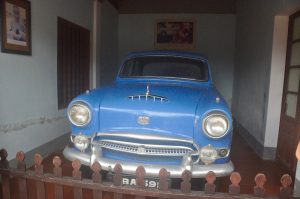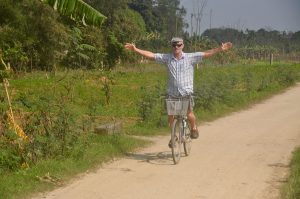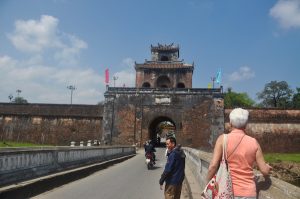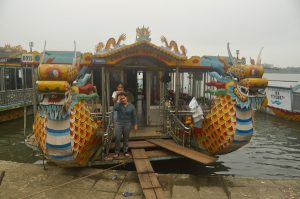 After a fourteen hour, overnight, train journey south, we arrived in Hue about half way down the length of Vietnam. We were met at the station by our new guide, Mr Tuong, and taken immediately to a restaurant for breakfast. Following breakfast, we walked down to the Perfume River, where there was a line of dragon headed boats moored along the bank. They were very crudely made with tin cut to a template and fixed together. The smiling faces of a couple and their two children assured us as to which boat we should step on to. As soon as we were all aboard, we were off, down river. The Perfume River gets its name from the fact that during the autumn the blossom from fruit orchards up stream falls into the river, flows downstream, and as it does so gives off a perfume like aroma. This was not the case as we travelled down the river, which was a muddy brown, like so many rivers in Vietnam.
After a fourteen hour, overnight, train journey south, we arrived in Hue about half way down the length of Vietnam. We were met at the station by our new guide, Mr Tuong, and taken immediately to a restaurant for breakfast. Following breakfast, we walked down to the Perfume River, where there was a line of dragon headed boats moored along the bank. They were very crudely made with tin cut to a template and fixed together. The smiling faces of a couple and their two children assured us as to which boat we should step on to. As soon as we were all aboard, we were off, down river. The Perfume River gets its name from the fact that during the autumn the blossom from fruit orchards up stream falls into the river, flows downstream, and as it does so gives off a perfume like aroma. This was not the case as we travelled down the river, which was a muddy brown, like so many rivers in Vietnam.
In the centre of the main cabin of our boat was a stall selling a wide range of gifts from ethnic clothing to jewellery, to paper crafts etc. The women in the group spent much of the journey satisfying their urges for some retail therapy, having been largely deprived of such opportunities so far during the trip. While they were engaged in that activity, the men took turns to pilot the boat. Anything was preferable to having the boat captain’s three year old daughter steering the boat.
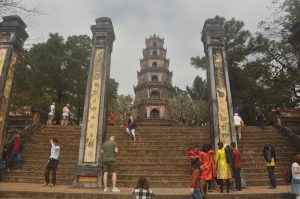 After some time we berthed to visit Thien Mu Pagoda, a seven tiered pagoda built in 1601. It has a prominent position, perched on a hill overlooking a bend on the north shore of the river. It also, clearly, has some significance with the local population, because there were many Vietnamese families, very smartly dressed, enjoying an outing during the Tet Festival. It was a time for family portraits, for children to be photographed at their best, creating lasting memories.
After some time we berthed to visit Thien Mu Pagoda, a seven tiered pagoda built in 1601. It has a prominent position, perched on a hill overlooking a bend on the north shore of the river. It also, clearly, has some significance with the local population, because there were many Vietnamese families, very smartly dressed, enjoying an outing during the Tet Festival. It was a time for family portraits, for children to be photographed at their best, creating lasting memories.
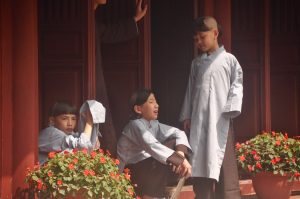 Beyond the fearsome guardians of the Pagoda, two giants with large, almost real, beards, the site opens out into a lawn area with a temple housing Buddha. Behind is a further lawn area with ornamental ponds, and beyond that pine forest. The temple is home to a particular sect of monks who wear brown or grey habits but stand out from other monks because of their very strange hair style. While the bulk of their head is shaved, a patch is allowed to grow untouched, often from one side of their head.
Beyond the fearsome guardians of the Pagoda, two giants with large, almost real, beards, the site opens out into a lawn area with a temple housing Buddha. Behind is a further lawn area with ornamental ponds, and beyond that pine forest. The temple is home to a particular sect of monks who wear brown or grey habits but stand out from other monks because of their very strange hair style. While the bulk of their head is shaved, a patch is allowed to grow untouched, often from one side of their head.
The most internationally famous monk from Thien Mu is the Venerable Thieh Quang Duc who drove to Saigon in 1963, got out of his car and sat in the cross- legged lotus position on the ground and meditated while fellow monks doused him in petrol and set fire to his body. The ritual suicide in protest against the anti-Buddhist regime of President Diem captured news headlines around the world. The car that he used to drive to Saigon is on display to one side of the complex.
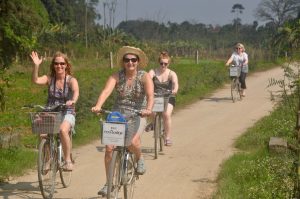 Returning to our boat, we continued our journey while the women continued their shopping. Eventually coming ashore on the south bank, we disembarked to find some bicycles waiting for us. We had to ride these in order to reach our accommodation for the night at Hue Ecolodge. This was a fabulous place, set in its own spacious grounds with trees and shrubs. The rooms were all individual bungalows, beautifully furnished. Not only did they have an en suite but also a private cobbled yard which also had a shower in it.
Returning to our boat, we continued our journey while the women continued their shopping. Eventually coming ashore on the south bank, we disembarked to find some bicycles waiting for us. We had to ride these in order to reach our accommodation for the night at Hue Ecolodge. This was a fabulous place, set in its own spacious grounds with trees and shrubs. The rooms were all individual bungalows, beautifully furnished. Not only did they have an en suite but also a private cobbled yard which also had a shower in it.
After freshening up, we again took to the bikes for a ride around the village. These bikes were not perfect by any stretch of the imagination. The seats were all fairly low and not in the most comfortable position for riding. They had seen some use. Nevertheless, we enjoyed, not only the exercise, but also seeing village life, which always seems to take place outside. Most people were enjoying being at home, with families, for the festival.
Returning to where we first met our bikes by the river, we were directed to an open dining area all laid out for a cookery lesson. We should have visited a market during our river trip earlier in the day, but because of the Tet Festival, the market was not open. Hence, our hosts had acquired all the ingredients we needed for our cookery session.
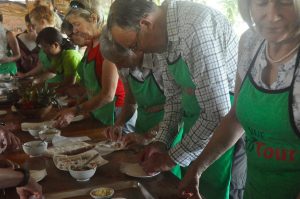 Donning pinafores we learnt how to mix the ingredients for spring rolls and the technique for rolling them. Then we set about making our own. Some, and I won’t name names, even made this simple task a competition to make the fastest, the best shaped etc. When we had exhausted all the materials, the freshly made spring rolls were whisked away and we learnt how to mix the ingredients for a second dish.
Donning pinafores we learnt how to mix the ingredients for spring rolls and the technique for rolling them. Then we set about making our own. Some, and I won’t name names, even made this simple task a competition to make the fastest, the best shaped etc. When we had exhausted all the materials, the freshly made spring rolls were whisked away and we learnt how to mix the ingredients for a second dish.
By now it was mid afternoon, and we had not yet had any lunch. Thankfully, the spring rolls were returned to the table, cooked, along with a great many more dishes, which we enjoyed.
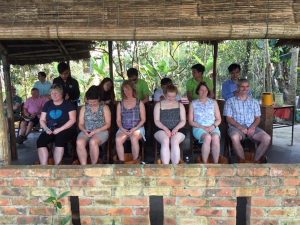 After lunch we were joined by some blind and visually impaired young people who gave us head and shoulder massages followed by lower leg and foot massages. Just what we needed before we headed back to the lodge on our bikes. There we took full advantage of the tranquillity of our surroundings, either by the pool or in the comfort of our air-conditioned rooms.
After lunch we were joined by some blind and visually impaired young people who gave us head and shoulder massages followed by lower leg and foot massages. Just what we needed before we headed back to the lodge on our bikes. There we took full advantage of the tranquillity of our surroundings, either by the pool or in the comfort of our air-conditioned rooms.
The following morning we had to leave this wonderful place. We could have done with at least another night there. Our itinerary dictated that we had to leave, so we boarded the waiting coach.
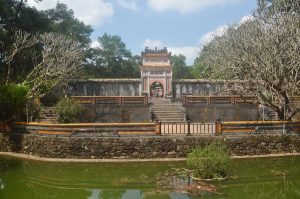 Our first destination was Tu Duc’s tomb. The story surrounding Tu Duc is far more interesting than the actual place, which, in places, is quite run down despite it being one of the most popular and impressive of the royal mausoleums. Renovations are taking place.
Our first destination was Tu Duc’s tomb. The story surrounding Tu Duc is far more interesting than the actual place, which, in places, is quite run down despite it being one of the most popular and impressive of the royal mausoleums. Renovations are taking place.
The tomb, constructed between 1864 and 1867. Emperor Tu Duc designed it himself to use before and after his death. From the entrance, a path leads to Luu Khiem Lake. The tiny island to the right, Tinh Khiem, is where Tu Duc used to hunt small game. Across the water to the left is Xung Khiem Pavilion, where he would sit with his concubines, composing or reciting poetry. Hoa Khiem Temple is where Tu Duc and his wife, Empress Hoang Le Thien Anh, were worshipped. The larger throne was for the empress; Tu Duc was only 153cm tall. 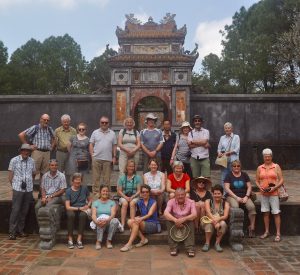 Around the lake shore is the Honour Courtyard. A guard of elephants, horses and diminutive mandarins (even shorter than the emperor) protect the route to the Stele Pavilion, which shelters a 20-tonne stone tablet. The tomb, enclosed by a wall, is on the far side of a tiny lagoon. It’s a drab monument and the emperor was never interred here although the paving slabs are uneven in places as a result of people trying to find where he lies with his treasure. Where his remains were buried is not known. To keep it secret from grave robbers, all 200 servants who buried the king were beheaded. Tu Duc lived a life of imperial luxury and carnal excess: he had 104 wives and countless concubines, though no offspring.
Around the lake shore is the Honour Courtyard. A guard of elephants, horses and diminutive mandarins (even shorter than the emperor) protect the route to the Stele Pavilion, which shelters a 20-tonne stone tablet. The tomb, enclosed by a wall, is on the far side of a tiny lagoon. It’s a drab monument and the emperor was never interred here although the paving slabs are uneven in places as a result of people trying to find where he lies with his treasure. Where his remains were buried is not known. To keep it secret from grave robbers, all 200 servants who buried the king were beheaded. Tu Duc lived a life of imperial luxury and carnal excess: he had 104 wives and countless concubines, though no offspring.
Moving on, we headed for the Forbidden Citadel, stopping briefly to watch the making of scented joss sticks at the side of the road.
The Forbidden Citadel is a walled fort surrounded by a moat. It was built in the early 19th Century. Behind the walls was the Purple City, the former home of the royal family, at a time when Hue was the capital from 1802 to 1945. Modelled on the bigger Forbidden Citadel of Beijing, there were a number of palaces for each of the royal family, Nugyen Dynasty. It must have been fantastic in its heyday. Today it looks very sad, with only about ten of the original 160 buildings surviving.
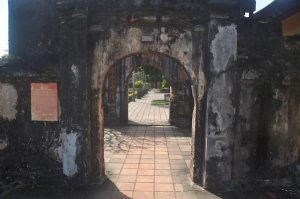 During the Vietnam War the Citadel was occupied by the Viet Cong, taking advantage of its strong walls, upon which they mounted many guns. The Americans were ordered not to damage such an important remnant of Vietnamese history, but the more casualties they received from the soldiers within the protective walls, the less caring they became. In the end the American attacked with force, bombing indiscriminately, killing many Viet Cong and destroying the vast majority of the palaces. For much of the area, there only remains charred walls, with weeds growing from cracks. The ground still bears the scars with bomb craters. It was sad to see it in such a state and I could not help but feel anger towards America and what it had done to this country, to these happy, smiling people, and for what?
During the Vietnam War the Citadel was occupied by the Viet Cong, taking advantage of its strong walls, upon which they mounted many guns. The Americans were ordered not to damage such an important remnant of Vietnamese history, but the more casualties they received from the soldiers within the protective walls, the less caring they became. In the end the American attacked with force, bombing indiscriminately, killing many Viet Cong and destroying the vast majority of the palaces. For much of the area, there only remains charred walls, with weeds growing from cracks. The ground still bears the scars with bomb craters. It was sad to see it in such a state and I could not help but feel anger towards America and what it had done to this country, to these happy, smiling people, and for what?
Work is taking place to restore some of the buildings, but it is an impossible job with very limited financial resources. It will take for ever.
Leaving the Citadel behind we were taken to the airport in time to catch our flight to Ho Chi Minh (Saigon) and the next stage of our Vietnam adventure. We said goodbye to our guide, who’s English and diction had not been anywhere near as good as Mr T’s, and, as a result, his ability to enthuse fell short of expectation. When you have two very different guides, it makes you realise just how important they are in giving you the best possible experience.

